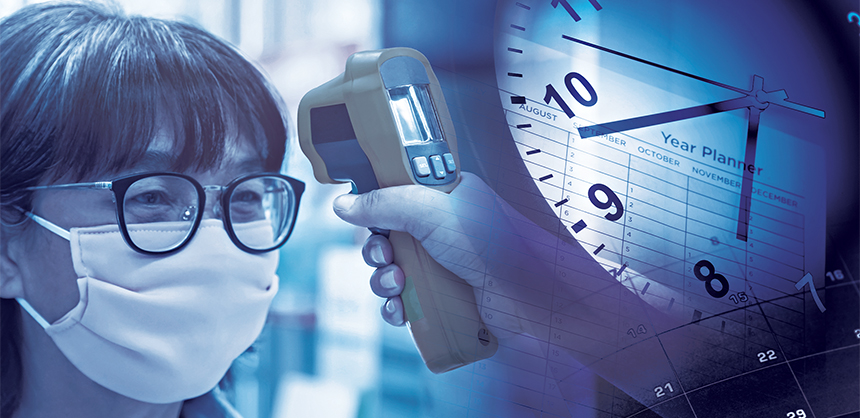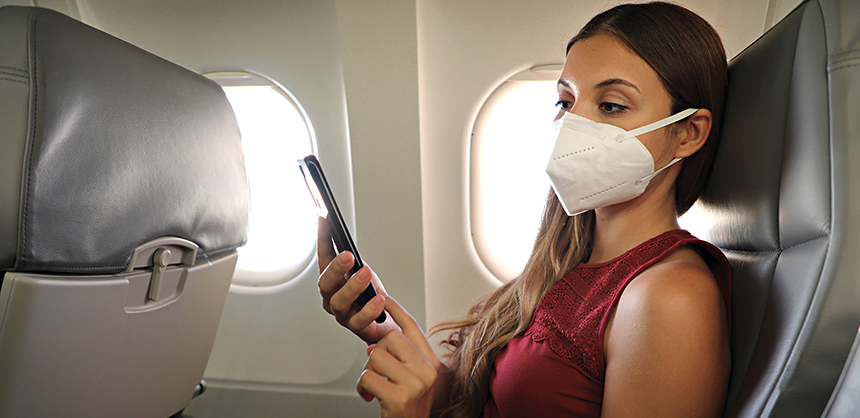Crisis ControlMarch 24, 2021
COVID-19 Forced Many Planners To Sharpen Their Leadership Skills By Patrick SimmsCrisis Control
COVID-19 Forced Many Planners To Sharpen Their Leadership Skills
DepositPhotos.com
Most planners are no strangers to on-the-job crises. They come in varying degrees of severity: the A/V system malfunctioning, weather disrupting an outdoor event at the last minute, an attendee becoming ill, and many other unforeseen scenarios. But rarely have planners had to contend with a crisis that sweeps the meetings industry as a whole and threatens their livelihoods. Two such instances are 9/11 and the Great Recession of 2008-2009. COVID-19, however, has caused a more thorough long-term shutdown of the industry than either of those crises, and its effects continue after the first meeting cancellations in March 2020.
Surviving any crisis requires a combination of resourcefulness, teamwork when possible, and a levelheaded disposition. The last one is not to be underestimated. Initially, crises typically engender a range of negative emotions such as shock, anxiety and despair. To handle the crisis optimally, these emotions must be reined in as they tend to compromise rational thinking. Indeed, when the pandemic escalated last March and cancellations became necessary, the first challenge for many planners was to get a handle on their emotions.
“Toastmasters International’s meetings team’s initial reaction to the escalation of the pandemic was total disbelief, and there was absolutely a degree of confusion on how to best proceed with our annual convention,” says Wendy Roberts, CMP, meeting planning manager, Toastmasters International. “The Toastmasters International Convention traditionally takes place in mid to late August, so with lockdowns being imposed five months ahead of our live date, we had to practice patience to better understand the full scope of impact on our event.” The shock and confusion were especially understandable given that, “since 1930, the annual Toastmasters International Convention has only been cancelled two times, and both were due to World War II,” Roberts adds.
A similarly distressing situation confronted the International Society on Thrombosis and Haemostasis (ISTH) with regard to its annual congress. “What initially happened is probably terror; terror for everyone,” says Lisa Astorga, CMP, DES, director of meetings, ISTH. “And this is not from the personal safety standpoint; this is from the business aspect of putting on the ISTH meeting. Obviously, you go through a gamut of emotions personally and professionally.” The ISTH congress was scheduled to take place in Milan, Italy, last year. “We were in full swing to finalize the meeting. In fact, we were in Milan for a site visit in December when Milan was unknowingly the epicenter [of COVID-19] in Europe,” Astorga says. “So, it was terrifying. We did not know what that next couple of months were going to look like, and had to quickly re-strategize, reinvent, re-collaborate; ‘re’ everything at that point. But, as planners, when we get into that [crisis] mode, we do some of our best work.”
For many planners, the work involved cancelling near-term in-person meetings and either shifting them to virtual or postponing them. But, the latter approach involved a difficult decision as far as timing, since the duration of the pandemic was uncertain. “We didn’t understand that it was going to last this long at the time, so we started thinking what programs we can move to possibly two to three months in the future,” says KC Doreste, CMP, director, meetings & special events, with the International Association of Amusement Parks and Attractions (IAAPA). “We thought by the summer everything was going to be ironed out and we would go back to normal.”

Planners say one of the biggest adaptations they had to make is realizing that the pandemic made all of that time spent cultivating those vendor and other relationships worthwhile. DepositPhotos.com
Doreste’s team ultimately decided to embark upon the mission of creating a virtual expo to be held in July 2020. After overcoming the emotional impact, the next step was to immediately “re-collaborate” around the upcoming event. That not only involved internal team members, but also the meeting’s vendors. “Our next program was going to be in China, so we had to quickly have open communication with our vendors,” Doreste says. “We put together many task groups to discuss what the next step is, what looked feasible. And, early on, one of the things we kept hearing is, it’s not a buyer’s market or a seller’s market, it’s a relationship market right now.”
Roberts relates a similar experience of mutual support in her dealings with vendors at that time: “We were fortunate to be working with partners and a venue that aligned on the fact that we were all in this together and circumstances were out of everyone’s control. We approached all difficult conversations with as much empathy and understanding that we could and came to a positive compromise.” Roberts continues, “Collaboration was key. The situation was so fluid that the only way to come to a positive solution for our organization was to include as many stakeholders as possible so we could gain a global perspective. The coordination of this effort took much dedication and hard work from the top to the bottom of our organization. It was truly inspiring to see so many come together to make positive change for the safety and well-being of all involved.”
New to Virtual Meetings
Planning and executing a virtual convention was a new endeavor for many associations, but it is typical of crises to push people out of their comfort zone and into the unknown. “We had never conducted a virtual event, and we made a huge leap into the digital event space,” Roberts says. “The entire organization had to learn quickly, and the planning process was now condensed into a 90-day pre-planning time frame. In that 90 days, we had to effectively coordinate our 119 participants to produce digital content that fortunately we were able to offer for free, while also working through the process of cancelling the in-person event.”
ISTH meeting staff were similarly thrown into deep waters they had to learn to navigate quickly. “The staff had never done a full virtual event. A lot of the basic platforms were there, but they had never gone through the full extent of what they were ready to do, so it was just a gamut of emotion,” Astorga says. “And so we just all put our heads together — the meetings team, marketing team, headquarters team, education team, along with our leadership — to try to make something work. It was a complete learning experience for the entire team. There was an extreme amount of time they had to put in. A few of us on the team have our DES [Digital Event Strategist] certification, and certainly that was helpful, but this was a completely new genre. We completely revamped our program to meet the needs of the virtual platform, dealing with international time zones. Being an international society, we had a lot of different challenges in meeting the needs of all of our attendees.”
Doreste’s team faced a rather steep learning curve that also included figuring out how to accommodate international attendees, as well as which virtual platform to use and how to structure the program. “One of the main things we needed to do is research virtual software. That was a very comprehensive work we had to do, and we put together a group of folks in the office and went through different demos,” she says. Like Astorga’s team, IAAPA meeting staff had to invest a lot of extra hours and even added a night shift. “Here in the U.S., we were doing the evening shift, working from 9 p.m. to 6 in the morning to accommodate our members in the Asia region,” Doreste says. Staff furloughs added to the challenge of executing the virtual event: “We had to pivot to a different style of working: answers you can normally have in 24 hours now you needed to wait maybe three or four days.”
Regarding the virtual program format, Doreste explains that “we learned that because you had a conference with a general session, meeting space and a trade-show floor, that doesn’t mean that we need to keep that same format for a virtual conference. An eight-hour day on the computer is very different than an eight-hour day in a convention center. So that was another learning curve for us.”
Tailoring the format to the remote attendee is key to engagement, which Beth Faubel, CED, DES, director, meeting services for HIMSS, regards as the “biggest challenge we faced. How do you create content that is new and fresh, and deliver it in a way that makes someone want to take time out of their day to consume it? I have had numerous conversations with industry colleagues, and we all feel that we thrive on the energy that face-to-face meetings bring. We like to feel, see and hear the excitement of the venue, the destination and the attendees connecting with one another. We now have to learn how to create energy in a virtual environment. I think PCMA Convening Leaders did an excellent job creating networking opportunities and energy within a virtual platform. I had numerous takeaways that I plan to incorporate into our hybrid event.”

Adjusting to Remote Workers
Along with the challenge of engaging remote attendees, planners faced the challenge of adjusting to a remote workforce. It fell upon the team leaders to keep their crew motivated and efficient under the unusual circumstances. “Managing a team that is now entirely remote creates a different team dynamic. However, I think the best thing I did when this all started was to acknowledge that it felt different. When you have a team that is as close as we are and relies on each other as much as we do, not seeing each other every day is impactful,” Faubel says. “Once we were sent to work from home, I set up a daily touch-base for the team first thing every morning so that we could remain connected. I noticed that the meetings quickly started to feel a bit ‘stale’ and that the team didn’t seem engaged. So I decided to make a change. My team is incredibly fun and creative, and I knew that if they had control of the meeting, they would make it far more fun than I ever could. So, each day of the week was assigned to a different team member and they ran the meeting that day. They could incorporate any type of game, icebreaker or conversation starter they wanted. It immediately changed the vibe of the meeting and it’s never gone back to ‘stale.’”
Faubel’s resourcefulness when faced with these challenging circumstances characterizes a leader. And finding solutions to the new problems brought on by the pandemic required composure and the ability to make clear decisions. Astorga takes pride in having shown both those traits. “I’m very proud that my leadership through this project was one of the driving factors that got us through it. It was very stressful. There were times when [the staff] didn’t exactly know what their role and responsibility was. So to maintain that composure, at least, was important,” she says. “And I think clear decision-making in itself is a form of leadership, [especially when] there is so much unknown. On the day to day, there are decisions that have to be made, and if you are intimidated by making a decision because of the uncertainty, you could get yourself lost very quickly.”
Given the amount of stress involved in adjusting to both a new meetings landscape and work environment, stress management becomes part of crisis management. Taking moments to decompress is even more important during the pandemic-fueled chaos. Both Faubel and Doreste found temporarily “disconnecting” invaluable. “I have always exercised, but taking a very long walk every day allows me to clear my head,” Faubel says. “Watching our industry get hit so hard overnight is disheartening. So, I use my time when I am out walking to listen to podcasts or music and just completely disconnect from the stress and the weight of everything that has gone on. I find that when I get back from a walk, I am ready to take on the next challenge.”
The information overload was another reason to seek a respite. “One of the things I had to do was disconnect, [since] we were getting information from all angles, including the TV and the news,” Doreste says. “It was overwhelming, and you lose focus on what you’re supposed to do on a daily basis. Your everyday routine has just been thrown away, so I had to put three things down I had to accomplish everyday and turn off that connecting time certain hours of the day.”
Looking Forward
Even with the development and deployment of vaccines, the current outlook still does not promise smooth sailing immediately for association meeting planners. Hybrid meetings are the new reality for most associations going forward, and these are, once again, a new format for many planners. But they also give members something to look forward to, says Astorga, who is planning ISTH’s hybrid annual congress slated for Philadelphia in July. The last in-person congress was back in 2019. “There is a little bit of excitement to potentially get back to some sort of face to face, given how much everybody misses it and how important the networking component is. That has been extremely difficult to replicate in a virtual environment,” she says.
Looking ahead, there is still uncertainty as to the trajectory of the pandemic, and so plans have to be flexible when it comes to the extent of safety measures at face-to-face meetings. “The safety and security for my team, our attendees, our supporters and the venue is first and foremost. Planning that is a challenge because we don’t know what [the necessary measures] will look like in July,” Astorga says. “For those that need something set in stone six months out, that uncertainty is causing a lot of anxiety.”
Roberts also acknowledges the difficulty of making plans in this state of flux, and so her team continues to collect risk data and keep tabs on the sentiment toward traveling among Toastmasters’ membership. “The international events landscape has not shown improvement [in] 2021. The team is closely monitoring international travel restrictions and guidelines, examining safety and risk management procedures, and adhering to recommendations by trusted local health and safety agencies,” she says. “Working closely with our partners and internal stakeholders, we are determining feasibility of hosting an in-person or hybrid meeting. However, our greatest concern is to better understand if our attendees, staff, volunteers and partners feel comfortable with traveling and attending an in-person event in 2021. Any safety and risk mitigation measures taken will not matter if attendees are uncomfortable with attending.”
It has taken resourcefulness, teamwork and composure, but association planners are shining through the crisis that COVID-19 has wrought on the industry. In so doing, many have developed new skills and are better prepared for the future of meetings. “Now we have the tools to plan it virtual, plan it hybrid or plan it face to face,” Doreste says. “We have different avenues to take, whereas before we didn’t know which way to go.”
These professional rewards, then, are the silver lining to the struggle that planners have undergone to keep members convening. “The disruption of the pandemic will mark a pivotal moment in my career that afforded opportunities that came out of necessity. Nevertheless, those opportunities have made me a better meetings professional, better supervisor and better employee,” Roberts says. “The experience I gained by practicing professionalism inside of a worst-case scenario, when all vulnerabilities were exposed, was invaluable.” | AC&F |








